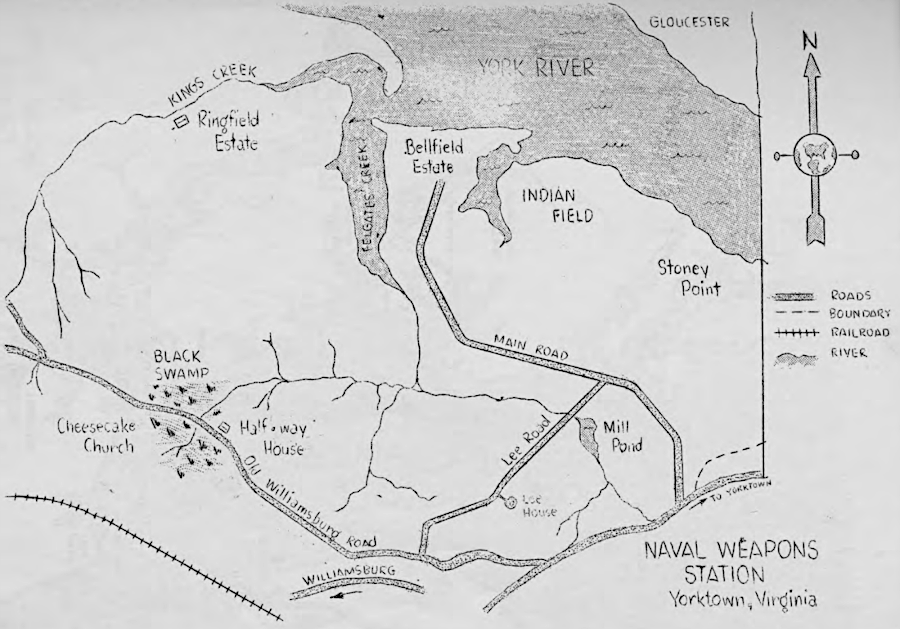
sketch of Naval Weapons Station Yorktown in 1961
Source: Susan Clingan, History Of The Naval Weapons Station Yorktown

sketch of Naval Weapons Station Yorktown in 1961
Source: Susan Clingan, History Of The Naval Weapons Station Yorktown
The site of the current Naval Weapons Station Yorktown was first settled by 200CE (Common Era). The six sets of officer's quarters at the modern military facility are built on a spot long known as "Indian Field."1
The Native American population increased after adoption of agriculture around 1300CE, but hunting deer and gathering plant food and oysters remained a significant part of the local diet.
After creation of towns, political alliances helped protect different groups living on the Coastal Plain. When the English settled at Jamestown in 1607, the Kiskiack tribe was part of Powhatan's paramount chiefdom. A weroance loyal to Powhatan was the local leader. In addition to food production, the Kiskiak processed clamshells and manufactured beads for trade.
The primary town of the Kiskiack (also spelled Chiskiack) was palisaded. Stone and bone tools had been used to cut trees and shape them into posts. Shovels made of wood, bone (including deer and elk shoulders), and stone were used to dig holes and trenches in which poles were lined up vertically to create a defensive stockade. Where poles were not placed close together, vines and branches closed the gaps and created a barrier against attack.
Archeology has revealed that while the town was palisaded:2
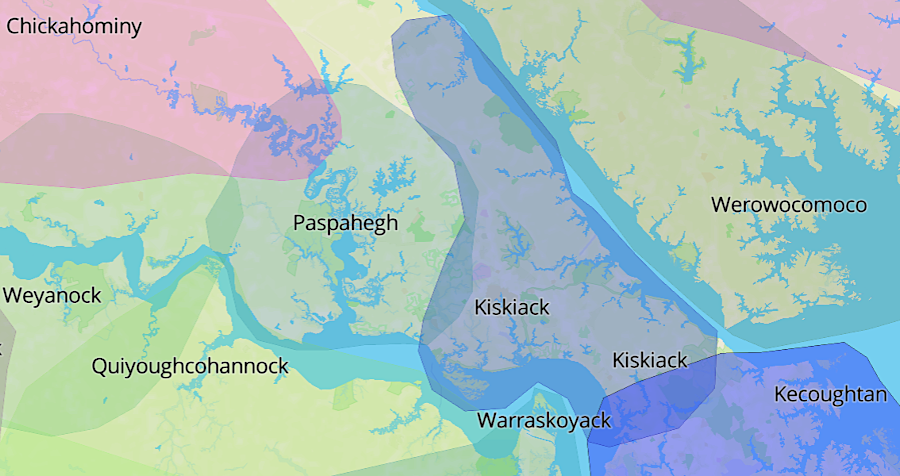
territory of the Kiskiaks when Europeans first arrived
Source: Native Land
The Spanish, rather than the English, were the first Europeans to disrupt Native American culture at Kiskiak. In 1561, a Spanish ship visiting the Chesapeake Bay took a young man from Kiskiack. The Spanish understood his name to be Paquiquineo.
The first attempt at a permanent European settlement in Virginia started in in 1570, when Spanish-speaking immigrants reached the site of what is now Naval Weapons Station Yorktown. A group of Jesuit priests arrived from Havanna to create a settlement called Ajacan. Father Segura and ten other Spaniards sailed up what was later called the James River, then walked across the Peninsula to Kiskiack on the southern bank of what was later called the York River.
The Jesuits may have wanted to settle at Kiskiak because it was near the home town of the Native American who had be taken in 1561 and brought bck with the priests from Havana. Since his capture, Paquiquineo had been taken to Spain and Mexico. He changed his name to "Don Luis" and appeared to have adopted the new Spanish culture. The priests expected him to serve as translator and help convert people to the Catholic faith.
The first European colonists arrived in September, 1570. They planned to trade with the Native Americans for food and rely upon their generosity until they could plant crops the next year. Kiskiack has been translated as meaning "broad or wide land," and the soil was productive there.
Father Segura may also have chosen to walk across what the English later called "the Peninsula" in order to get closer to Werowocomoco. That town, about a dozen miles upstream of Kiskiak on what is now called the York River, was the religious center of the local tribes. The Jesuit priests were challenging the Native Americans to abandon their religious perspective and to adopt Catholic rituals, in addition to creating an outpost to deter the French from creating another settlement on the East Coast of North America.
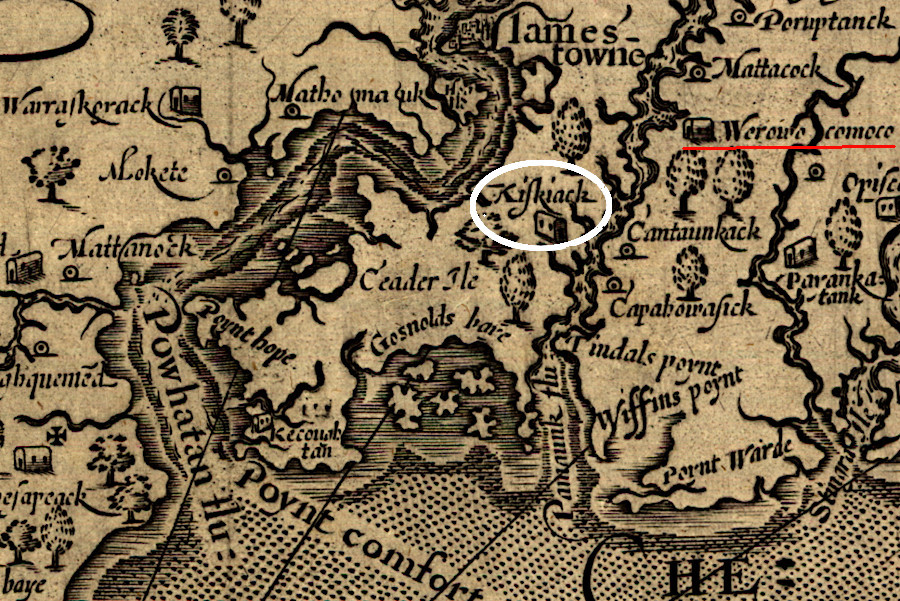
John Smith documented that Kiskiack was about 12 miles downstream from Werowocomoco
Source: Library of Congress, Virginia (by John Smith, 1624)
Once back in Virginia, "Don Luis" quickly abandoned the Spanish. That limited efforts for religious conversion and trade except through sign language. Spanish hopes for voluntary support by the Native Americans were unrealistic, especially because they had arrived during a severe drought when there was little food to trade. After acquiring their valuable metal items in exchange for food, the Native Americans finally killed all but one Spanish boy in February, 1571.3
Ottahotin was the weroance when the English colonists arrived nearly four decades after the Spanish. The town, with perhaps 200 occupants, was part of Powhatan's territory known as Tsenacomoco (Tsenacommacah):4
The English colonists pressured the Kiskiacks to provide food, but soon sought to seize their land. The Kiskiack were forced to move from their town on what they called the Pamunkey River after the start of the Second Anglo-Powhatan War in 1622. The vestry of the Hampton Parish built a brick church at the headwaters of Felgates Creek in 1700. It was called the "Cheesecake church," a name derived from Chiskiack.
The land was patented by Captain Robert Felgate in 1630.
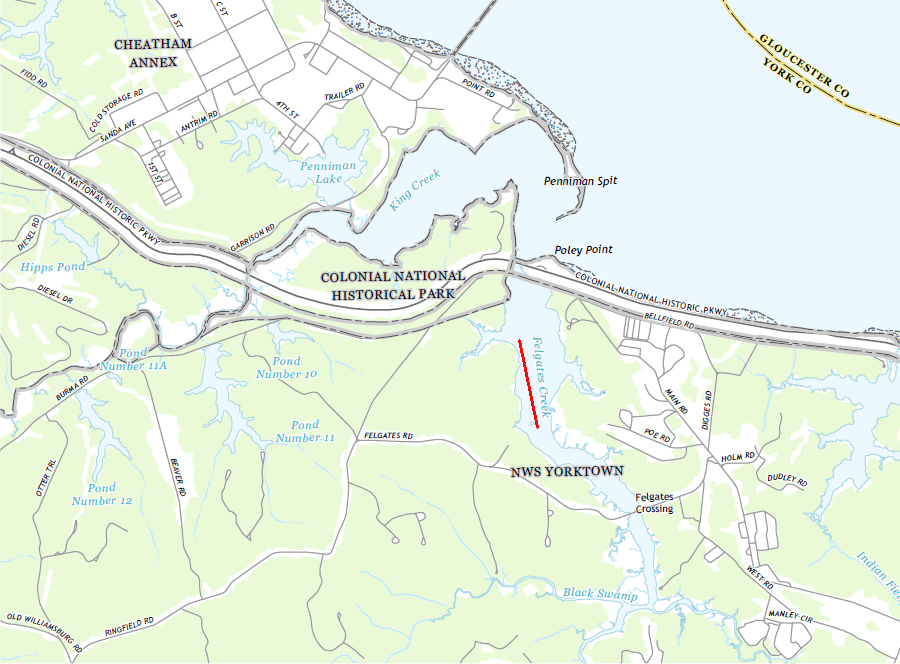
the family of the first Englishman to patent land at Naval Weapons Station Yorktown is remembered by "Felgates Creek"
Source: US Geological Survey (USGS), Clay Bank VA 1:24,000 topographic quadrangle (2019)
The 1632 peace agreement with Opechancanough included a provision for building a wooden palisade across the Peninsula between Archers Hope Creek (now known as College Creek) on the James River and Queens Creek on the York River. Only the colonists such as Felgate could live south of the wall.
Joseph Ring, a trustee of Yorktown, acquired the property in 1692. The US Navy seized land of the Ringfield Plantation, as well as "the reservation" and the Indian Field.5
The Navy Mine Depot Yorktown was created by presidential proclamation on August 7, 1918, three months before World War I ended. The US Navy needed a location to stockpile underwater mines, which had been manufactured elsewhere, before shipping for placement in the North Sea to interfere with German ship movements during World War I:6
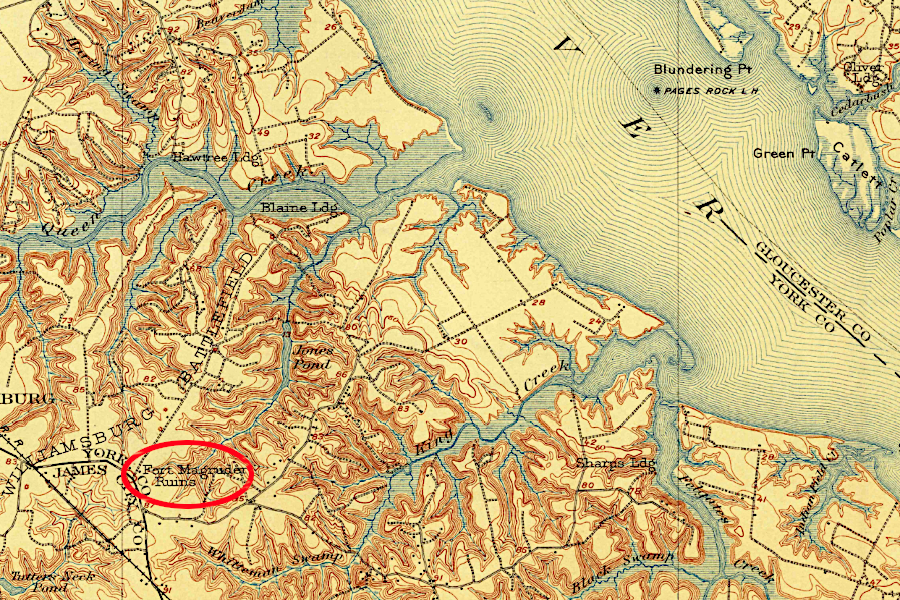
much of Civil War-era Fort Magruder was flattened in 1916 to created DuPont's dynamite plant and housing at Penniman
Source: US Geological Survey (USGS), Williamsburg 1:62,500 topographic quadrangle (1906)
Residents were given thirty days to move. Some were African-Americans working as watermen or farm laborers, living on land which was called informally "the reservation."
There had been informal ownership arrangements since free blacks had acquired rights to use the land even before the Civil War. The Federal government required legal deeds, however, and no compensation was paid to residents who could not document their title to acreage. The military base's website in 2023 highlighted the history of the site, but made no mention of displacing residents.7
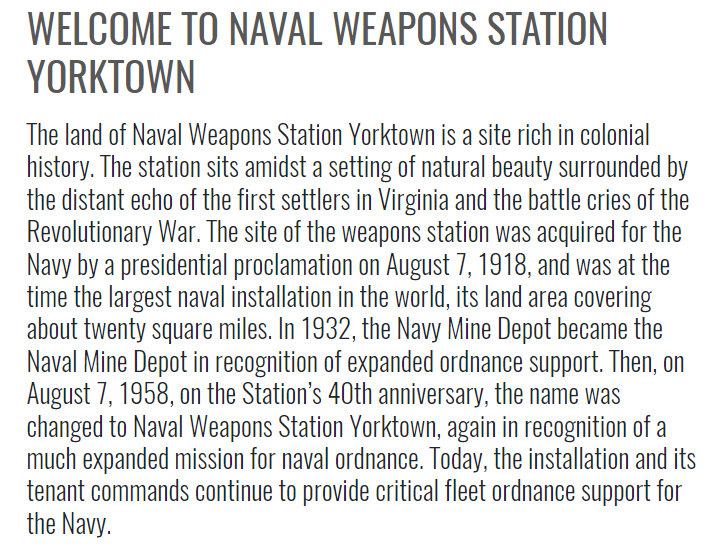
in 2023, the history of the creation of Naval Weapons Station Yorktown omitted how the black residents on "the reservation" were displaced
Source: US Navy, Naval Weapons Station Yorktown
The acquisition of 12,562 acres made it the largest US Navy base in size, at the time. The Commonwealth of Virginia sold its submerged land down to the 30-foot depth line, so the US Navy acquired 1,274 of underwater land as well as 11,288 acres of solid land and marsh.
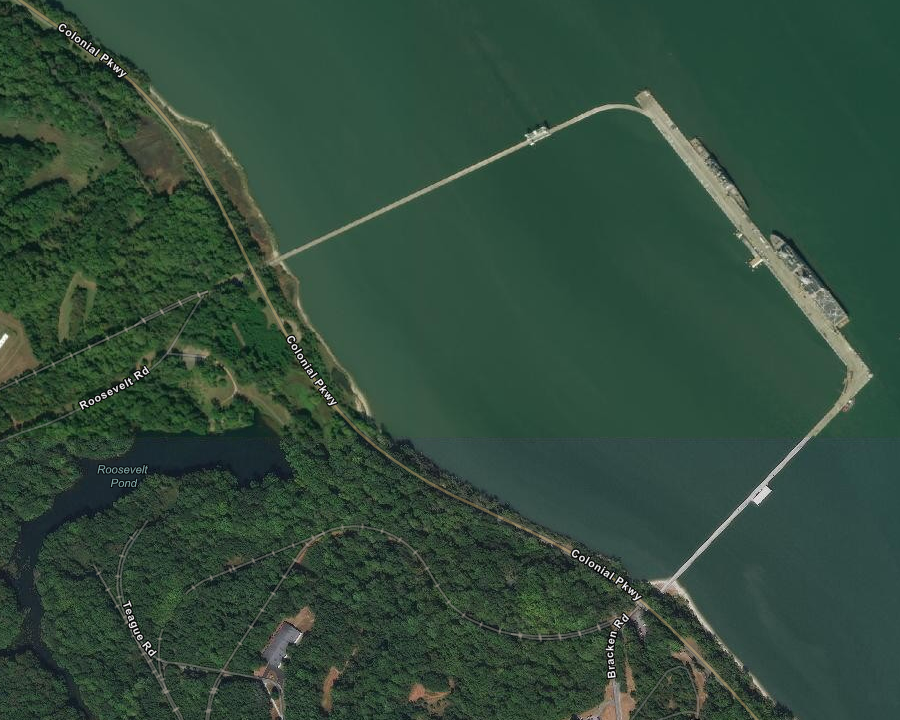
the distinctive U-shaped pier at Yorktown Naval Weapons Station is on Federal land, since the US Navy purchased submerged land from Virginia
Source: ESRI, ArcGIS Online
In 1932, the facility's name was changed to Naval Mine Depot. On its 40th anniversary in 1959, it was renamed Naval Weapons Station Yorktown. The acronym NWSY has now been replaced by WPNSTA.8
In 1916, the DuPont Powder Company began to build a dynamite manufacturing plant on the York River. The Chesapeake and Ohio Railroad built a spur line to the new facility.
By 1918, there were 15,000 people living at Penniman.9
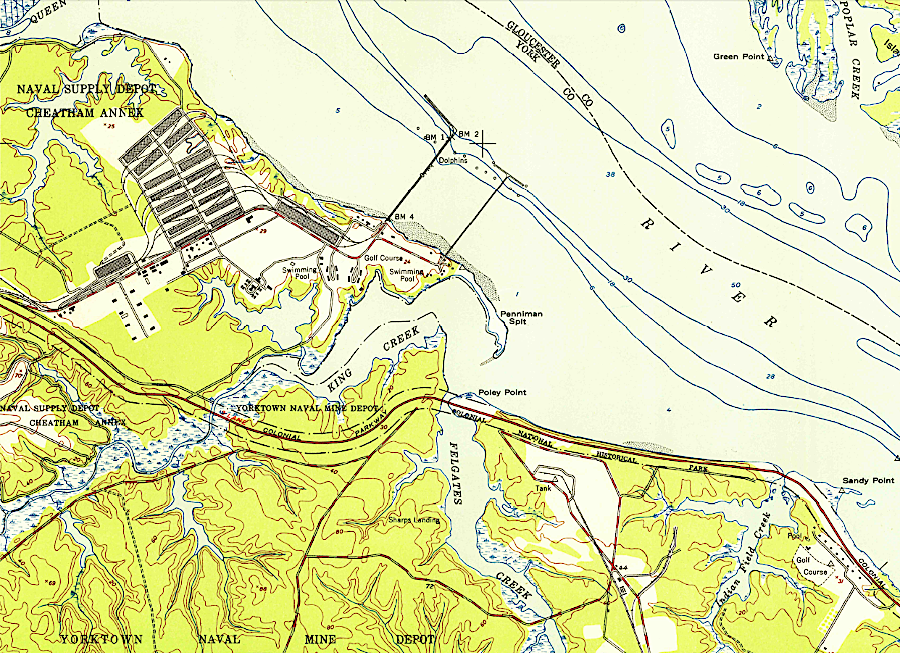
the Colonial Parkway separates the Yorktown Naval Mine Depot and Cheatham Annex
Source: US Geological Survey (USGS), Clay Bank 1:24,000 topographic quadrangle (1952)
In 1944, research and experimentation with high explosives began at Yorktown. One result was contamination of soil and groundwater with TNT, RDX, HMX, and 2,4 -DNT. At greatest risk were surface streams and the Yorktown Shallow Aquifer. The principal artesian aquifer, in Cretaceous-age sediments 450 feet below the surface at the military base, was not affected. Its primary recharge area is far to the west, in Henrico, Hanover, and western King William counties. The base stopped using well water and connected to the Newport News water system in the later 1970's.
The site was assessed under the Comprehensive Environmental Response, Compensation and Liability Act for environmental hazards, and in 1992 was added to the Environmental Protection Agency's National Priorities List. Remedial work included assessing the skeet shooting range for lead and polynuclear aromatic hydrocarbon contamination, in addition to places where munitions processing had created contamination. A report concluded in 2006 that consumption of fish from the ponds on base did not pose a health hazard, in the past or currently, and:10
Cheatham Annex added to the Superfund program's National Priorities List in December 2001. Contamination at the site started back in 1916 when the DuPont de Nemours Company built its dynamite plant, before the US Navy acquired the property in 1943 to store and assemble munitions. 18 locations were identified as "sites" or "areas of concern." Starting in 1987, the military has removed drums, tanks, surface debris and nearly 2,900 cubic yards of contaminated soil from the site, and stabilized the landfill to ensure the clay cap remains intact. Some sites still remain under investigation for determining if remedial action is appropriate.11
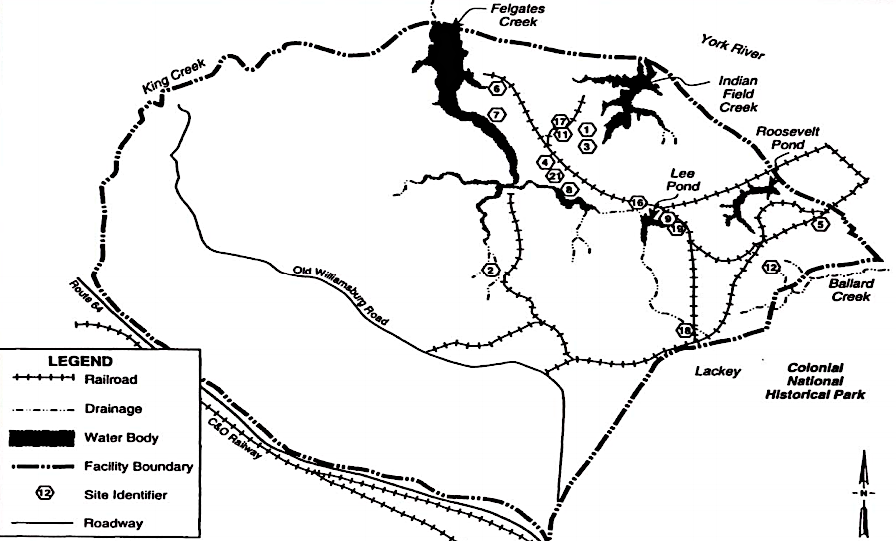
locations for sources of contamination at Naval Weapons Station Yorktown (NWSY)
Source: US Department of Health and Human Services, Public Health Assessment for Naval Weapons Station York Town (NWSY) (Figure 2)
The US Navy has supported archeological research at the site, working in particular with the College of William and Mary. Data from the research is used to avoid or mitigate damage to cultural resources from land disturbance. The discovery in 2004 of two tiny squares of copper, with a distinctive chemistry showing they had been acquired from European sailors or directly from Jamestown, confirmed the location of the Native American town.
According to Dr. Martin D. Gallivan, associate professor of anthropology at the College of William and Mary:12
The Navy Cultural Resources Manager for the site echoed that perspective:13